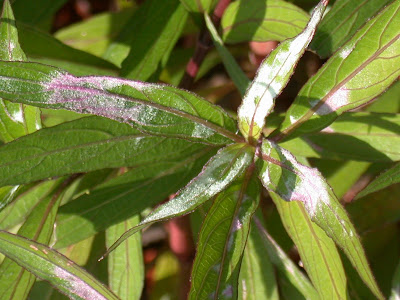 Is anyone treating this "ailment" on Mexican petunia (Ruellia spp.)?
Is anyone treating this "ailment" on Mexican petunia (Ruellia spp.)?OR is it a NBD--no big deal?? Searching for feedback. Answer may be revealed in a few days in an effort to get more input into this BLOG...........
OK, This is NOT a disease! Another landscape phenomenon has created a little controversy as it occurs on Mexican petunia (Ruellia species). Plants are developing white woolly patches on their leaves and stems and people are wondering if it was powdery mildew or a chemical residue. Turns out it is neither.

It is a type of growth distortion called an erineum and it is caused by tiny mites called eriophyid mites (Acalitus ruelliae). The white, tear-drop shaped organism in the center of the picture (3rd image) is one of the mites. This microscope picture shows the distorted growth (resembles fungal mycelium in appearance!) of the Ruellia leaf. 
I doubt treatment is ever needed although there is some leaf distortion. After all, this is a plant which seemingly prospers after an application of Roundup herbicide! But perhaps this information on this bad-mouthed plant may save some people from wasting their money and time on a misdiagnosed fungicide application.
Some landscapers were wondering why worry about this aggressive plant that shouldn’t be used. I reminded them that there is the seedless variety, “Purple Showers” and not to get bent out of shape about seeing it in the landscape. Then they reminded me that it is aggressive just by its flopping vegetative growth habit and runners which cause small plants to grow into large stands of lovely blue flowering shrubbery. My one and only viewing of a malachite butterfly was when it was hovering around my Mexican petunias, a reported host plant!
WHAT TO DO: A horticultural, paraffinic, mineral oil (say, 2% concentration) should do the mites in. Repeat every 5 to 7 days for a total of 3 applications.

I doubt treatment is ever needed although there is some leaf distortion. After all, this is a plant which seemingly prospers after an application of Roundup herbicide! But perhaps this information on this bad-mouthed plant may save some people from wasting their money and time on a misdiagnosed fungicide application.
Some landscapers were wondering why worry about this aggressive plant that shouldn’t be used. I reminded them that there is the seedless variety, “Purple Showers” and not to get bent out of shape about seeing it in the landscape. Then they reminded me that it is aggressive just by its flopping vegetative growth habit and runners which cause small plants to grow into large stands of lovely blue flowering shrubbery. My one and only viewing of a malachite butterfly was when it was hovering around my Mexican petunias, a reported host plant!
WHAT TO DO: A horticultural, paraffinic, mineral oil (say, 2% concentration) should do the mites in. Repeat every 5 to 7 days for a total of 3 applications.


